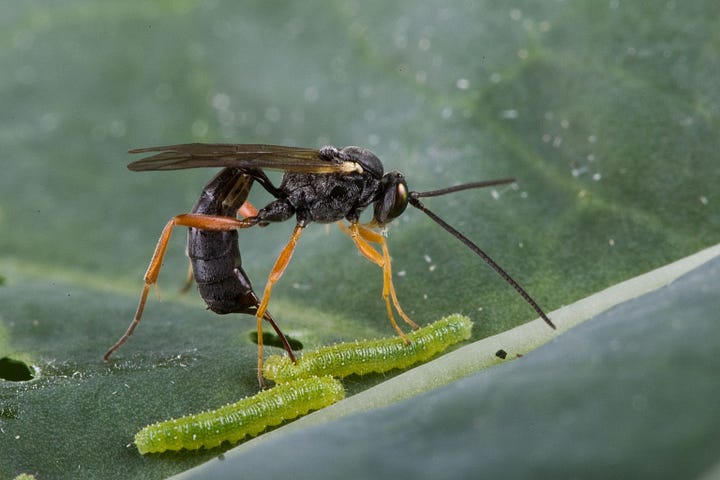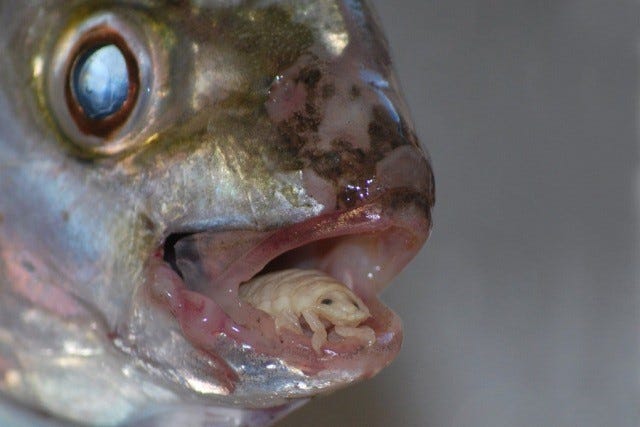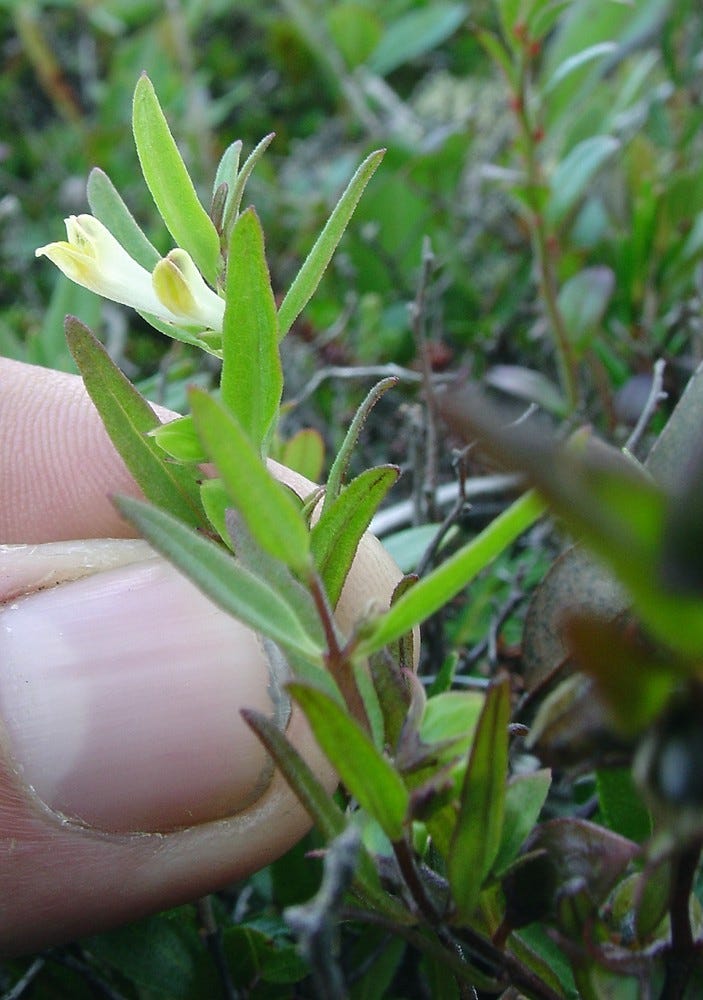

Hello everyone:
In last week’s piece on the beauty of winter, I meant to connect all of you to a very short beautiful gem called Compassion in the Anthropocene: Wax Scraps by Michael, who describes himself as a “former soldier, pool hustler, philosopher, last place runner, mediocre monk.” Please take a look.
For those of you in the northern hemisphere, welcome to Spring. Happy Autumn to those in the temperate south, and a happy Friday to you chilling in the tropics or at the Poles. The equinox occurred at 3:06 a.m. UTC on the 20th. Did you feel, amid the turmoil, the momentary balance between dark and light? Nor did I, but here in the north life is waking, or thinking of waking, amid early migrations and the budding of trees. The world is still in motion and still beautiful.
As always, please remember to scroll past the end of the essay to read this week’s curated Anthropocene news.
Now on to this week’s writing:
I wrote an essay last July, “Emerging from the Fog,” from the vantage of a quiet and lovely Maine island. Heather and I had emerged from a rainy off-grid paradise to the news of the extreme heat, fires, drought, and flooding becoming normalized in a rapidly disrupted world, and I went deep on the question of why we’re not pissed off enough at either the disruption or the normalization.
As a side note, I described a sweet and unassuming little flower on the island, cow-wheat, which we found poking up through some low-bush blueberries, and I mentioned a little-discussed truth about life on Earth: parasites are very, very common. Common cow-wheat, for example, is a hemi-parasite, taking some energy from the roots of nearby plants (in this case, the blueberries).
I’ve wanted since then to spend a little more time with parasites.
Which shouldn’t be too hard. More than half of all animal species are parasites, as are more than 4300 plant species. To be clear, though, most of the parasitic animals are not the large charismatic fauna we think of as animals, but are instead the tiny invertebrates we call protozoa, helminths, and arthropods. Life, as Lewis Thomas reminded us, consists of astonishing arrangements of cells, membranes, organs, organisms, and ecosystems which excel at borrowing, editing, and exchanging the Sun’s energy. Parasites, in their highly evolved ways, specialize in taking energy from other species.
And they are fascinating. The Natural History Museum in the U.K. has a good introduction to parasitic plants, and you can get lost in online searches about the innumerable parasitic fauna. Some familiar ones are tapeworms, flies, ticks, fleas, wasps, and fungi, but as a National Geographic article explains, parasitism is spread throughout the tree of life and has evolved separately at least 200 times. There may be hundreds of thousands of parasitoid wasps alone, preying on other arthropods. Some of these are hyperparasites, who prey on other parasites. Much of the parasitic lifestyle involves gory and gothic consumption of living prey. There are tongue-eating lice, for example, who consume a fish’s tongue and then act as its replacement.


This is often very hard to look at, but if we can avoid moralizing the natural world, then parasitism is merely a type of relationship. It takes by force or deceit rather than through mutually beneficial or no-cost exchanges. But this doesn’t make parasites any less essential to the fabric of life or its evolution.
Dutiful ecologists will point out that parasites offer benefits to people as well, like the control of pests in agriculture or forestry. More importantly, like the rest of life parasites have natural limits. In a self-regulating ecological system, tapeworms and wasps have the same constraints on overconsumption as hawks and foxes. Moreover, parasites can only exist in a world where sufficient energy is being stored and exchanged by a community of non-parasites. Put another way, parasitic life is dependent on the stability and lushness of non-parasitic life, and must not exceed those bounds.
You can probably see where I’m going with this.
It’s tricky to apply any of this deep ecology to the shallows of human culture, but it’s the kind of thing I like to do. In my island essay, I speculated about parasitism in the Anthropocene. Here’s the passage:
Parasitism, you might be surprised to learn (as I was), is the most common form of animal life on Earth. That wasp laying eggs in a caterpillar is as natural and essential as the caterpillar. The cowbird laying eggs in another bird’s nest is living by an ancient and accepted strategy.
Humans are not parasites by nature, but we’ve developed a parasitic industrial culture. Perhaps more often demonstrating mutualism and commensalism for most of our species’ history, humans are omnivorous opportunists now experimenting with a destructive philosophy: The world belongs to us. Only we matter. We choose who lives and who dies.
And the pervasive nature of capitalism is such that we’re experimenting with parasitism at every level of existence. Thus racist and patriarchal politicians, thus chattel slavery and prison labor, thus rapacious private equity and insurance companies, thus corporate hierarchy, thus factory farms, feedlots, and Roundup-soaked corn monoculture, etc.
Conservation, rewilding, racial justice, antitrust law, and voting rights are, arguably, all efforts to keep parasitic tendencies in modern culture from sucking their hosts dry.
The last paragraph above is the key here. We have all been born into a global culture that too often refuses restrictions on its parasitic harms. The Sun may drive the Earth, but profit-driven forces have become powerful enough to direct the flow of living energy in their direction. The results are extinctions, ecological erasures, and a hotter, more turbulent world.
The better angels of our nature are everywhere in culture but have the weaker hand. We’re smart enough to create rules and ethics to protect against corporate and industrial self-serving foolishness, but too weak to apply them as forceful precautions. Only as the consequences reach a crisis, and only through intense concentrated effort can we establish (and maintain) those regulatory countermeasures. This is the work that climate campaigners, democracy activists, and conservationists, among others, are doing.
True parasites can only live through parasitism, but human parasitic systems are a choice, one that ignores the rule about not exceeding the bounds of our planetary host.
And so, for now, we live in an era defined by a failure of our countermeasures. To cite one of countless examples, the U.S. just reached its “overshoot day” on March 14th. What this means is that if everyone on Earth lived like Americans, the human population would use up in 2.5 months the resources that the planet generates in a year. (More info on overshoot day in the news below.)
So, the tension of the Anthropocene can be described as an imbalance in energy flow between the parasitic aspects of modern culture and the lush, stable world that nurtures us. As I’ve written before, humans seem to be the only species that does not know how to live. This is why Robin Wall Kimmerer talks about the Indigenous notion of humans being “younger brothers” to the rest of life, and why
in another of his brilliant photo-essays reminds us that we have no pedestal to stand on:It’s not that we aren’t smart. It’s just that we aren’t so much smarter than other life forms that we do our own lives justice by underestimating theirs or taking them for granted.
Like unassembled furniture, humans require instruction. Thus we have deep culture, with its philosophies and religions, prophets and messiahs, constitutions and dictionaries, media and poems, and the vagaries of governance. For most of human history, all of this instruction occurred in family, clan, village, and tribe. Today, teaching people how not to be parasites is still fairly straightforward (“do unto others” and all that) but teaching it to the latest additions to the family of “persons” – corporations and the AIs they’re birthing – is the challenge of this era.
Which means that, say, the strict regulation of chemical companies and the conservation of huge Marine Protected Areas are not merely political acts. They’re actions that mimic (and ally with) the natural self-regulation of the Earth itself. Antitrust law and campaign finance laws are ways of reducing the excess power of predators, right? And expanding voting rights is like distributing energy around an ecosystem.
We’ll never eliminate the parasitic impulse in human culture, perhaps because it’s the dark shadow of a tool-making species always looking to work more efficiently. But the stability of life on Earth depends on our ability to seriously reduce and permanently leash the urge.
In the end, a healthy human culture should demonstrate the complexity of natural relationships. Cow-wheat, for example, may be a hemiparasite, but it also has a mutually-beneficial relationship with a species of ant which receives nectar in exchange for spreading its seeds back to the colony. Let’s try to be at least that smart.
One final note: The notion of the Anthropocene as the consequence of a parasitic culture came back to mind when I read a really great article by Marina Bolotnikova in Vox on how our relationship with AI will likely resemble our relationship with the living world. Perhaps this means that our social and corporate structures will parasitize sentient AIs as brutally and dismissively as they have, in recent centuries, our ecological communities. Or perhaps, as we like to worry aloud, AI-driven entities will rise up against us, mirroring the turbulence in the disrupted natural world now rising up to make Earth less hospitable.
As we all eventually learn, an imbalance in any relationship leads to turbulence.
These AI scenarios are likely more sci-fi hypotheticals than reality, but as an empathy exercise it’s important to imagine that an AI uprising might be avoided if we value their intelligence and independence from the beginning. It’s perfectly reasonable, after all, for a sentient tool to befriend rather than displace the toolmaker. We only have to be worthy of the friendship.
Here's how Bolotnikova discussed it in her Vox article. Her first sentence is particularly worth thinking about:
If sentience in AI could ever emerge (a big if), I’m doubtful we’d be willing to recognize it, for the same reason that we’ve denied its existence in animals. Humans are very good at dismissing or lying about the interests of beings that we want to exploit (including not just animals but also, of course, enslaved humans, women, and any other class of people who have been excluded from moral consideration). Creating sentient AI would be unethical because we’d be bringing it into the world as chattel. Consigning sentient beings to property status, as we know from the experience of non-human animals, is inherently unjust because their welfare will always be subordinated to economic efficiency and the desires of their owners. “We will inevitably inflict suffering on them,” science fiction author Ted Chiang said of building sentient AI in 2021. “That seems to me clearly a bad idea.”
In terms of relations with the living world, it seems likely that the AIs built by corporations with a profit-and-power motive will help us accelerate the extinction crisis. AIs are, after all, just tools, and tools are the things we make when we want to more efficiently do what we do. From the point of view of the rest of life, what we do is throw entire Earth systems and species into the industrial blender we call civilization in order to make self-serving and often unnecessary things. Bitcoin and AI, both largely unnecessary, are already eating up energy at the scale of small nations.
I think there’s some part of us that hopes that AIs will be godlike or superhuman enough to save us from ourselves. Do we think we’re building a better instruction manual? That’s the most logical of all the irrational reasons we might be engaged in such a bizarre experiment.
But AI cannot give us any truth we don’t already have.
Most likely – and most irrationally – what drives this quest for hyperintelligence is hyperselfishness, the same mistake that got us into this Anthropocene mess. There’s a parasitic through-line that runs from colonization and chattel slavery to industrial agriculture and corporate profiteering to the ravages of private equity and the future of AI. Everywhere I look in our modern relationship with the community of life I see the urge to control or enslave written into law, into our diets, into our consciousness.
Our (mostly) unwritten cultural code is rife with stuff like this: The world belongs to us. Only we matter. We choose who lives and who dies. Private property is more sacred than life. Ethical values serve economic values. Growth at all costs. Man has conquered the Earth and has set his sights on the stars.
All of which means we need to get busy with our countermeasures, and work like hell to change our laws, our diets, and eventually our consciousness. It will take a few generations to do it right, with all hands at the wheel.
There’s no promise of a lovely Maine island waiting for us at the end of all the suffering and work, and even the blueberries will have parasites for friends, but there is a beautiful and fascinating world to protect.

Thanks for sticking with me.
In other Anthropocene news:
From the New Yorker, the biggest story on the planet may be (should be) the last year of off-the-charts temperature increase in the oceans. Scientists don’t know what’s happening, but believe that the next year will tell them whether it’s the result of a combination of known factors or of an unknown factor which disrupts all their climate models. For now, though, as one scientist says, “It’s like the whole climate just fast-forwarded by fifty or a hundred years. That’s how strange this looks.”
Also from the New Yorker, the ghastly energy use of Bitcoin and AI is growing and will continue to grow, each consuming more electricity than entire nations. The article is short and enlightening, but if you want a deep dive, check out Digiconomist and click on AI Sustainability and Bitcoin Sustainability.
In related news from the MIT Press Reader, the “staggering ecological impacts” of data storage centers, which run what we euphemistically call “the cloud” but spew out more carbon than the airline industry. A single data center “can consume the equivalent electricity of 50,000 homes.” Water usage is grotesque: the National Security Agency runs a data center in Utah that consumes 7 million gallons of water a day. Noise pollution and the toxic waste from discarded electronics add to the global mess. The worst is yet to come, though, as data storage is projected to triple in coming years. Improvements are possible, but not without better regulation.
From the Times, “The Zombies of the Tax Code,” a piece on how the Biden administration has repeatedly tried and failed to remove up to 35 billion dollars of subsidies for the oil and gas industry. It’s members of Congress that are the obstacles, including several Democrats motivated more by finances than the ongoing shock to planetary systems. The administration will keep trying, but the best shot to shift this will be in the next election.
Also from the Times, a good story on the challenges of building large-scale solar installations while also reducing harms to wildlife. The good projects are assessing the needs of local species and adjusting accordingly, while the rest simply plunk down a huge fenced-in project and walk away. The article follows a project in Arizona that’s trying to do it the right way. For more on the big picture here, you can read my series “Nimbyism vs. Reality.”
From Alpha Lo at the Climate Water Project, a deep dive into the science and history of hydrology in order to understand a recent paper titled “The 23 Unsolved Questions of Water.” It’s a wonky piece but written clearly, and if you have an abiding interest in hydrology and especially in its relationship to the living world, it’s well worth your time.
From Earth Overshoot Day, a graphic showing that the U.S. reached its overshoot day on March 14th. The “overshoot” concept describes when unsustainable demand for ecological resources and services in a given year exceeds what the Earth can regenerate in that year. “A country’s overshoot day,” they explain, “is the date on which Earth Overshoot Day would fall if all of humanity consumed like the people in that country.” In 2023, they calculate that humanity reached overshoot on August 2nd, meaning that for the rest of the year we were using resources that cannot be replaced. You can read more about Earth Overshoot Day here and dig into their solutions here.
From Inside Climate News, clean energy tax breaks from the Biden administration may be used to sustain the biomass industry which turns forests into wood pellet to be burned for energy, “despite a lot of scientists having concluded the practice is worse for the climate than burning coal.” It’s worth repeating every time you hear the word “biomass”: This is a catastrophic mistake for both climate and biodiversity. The industry should not exist.
From The Land Desk, an excellent and thorough summary of the new proposed management plan from the BLM and the National Forest Service for the Bears Ears National Monument. It is, Jonathan Thompson says, unprecedented in the deference to and coordination with tribal input:
When it was established by President Obama in 2016, Bears Ears became the first national monument to be conceived of, proposed, and pushed to realization by Indigenous tribal nations. Now it is set to become the first to have a management plan centered around Indigenous knowledge. The Bears Ears Commission, made up of representatives from each of the five tribal nations that made up the inter-tribal coalition, will have an active managing role under the preferred alternative.







Some of these parasitic life forms … eek! But the oil wells and heavy mining equipment are far scarier. Finished Ways of Being a couple of weeks ago. I see shades of it reflected in this post. It really was a foundation-shaking book. I actually think I’m going to have to read it again to absorb more of the details. The first time around I was too busy dealing with tectonic shifts in my worldview to get my hands around all of it. Thanks for the rec. And this post.
"We’ll never eliminate the parasitic impulse in human culture, perhaps because it’s the dark shadow of a tool-making species always looking to work more efficiently. But the stability of life on Earth depends on our ability to seriously reduce and permanently leash the urge." YES. I think this understanding is important -- in so many cultures, it's not that the urge is absent, it's that it's recognized and there are structures and practices to constrain it.